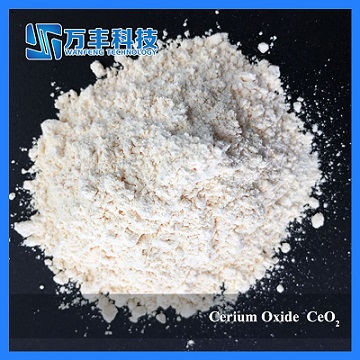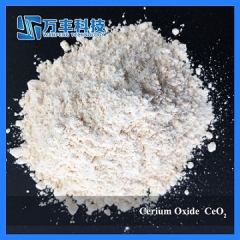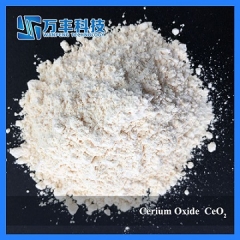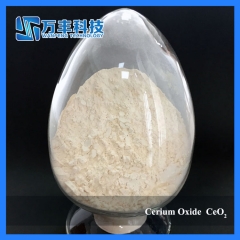Cerium Oxide
Cerium oxide, CeO2, Oxidizing agents. Catalysts for Organic reaction. Use rare earth metal standard samples for steel analysis. Redox titration analysis. Discolored glass. Glass enamel sunshade. Heat resistant alloy.
Used as an additive in the glass indu
Used as an additive in the glass indu
Details
Application of cerium oxide
Rare earth polishing effect
Rare earth polishing powder has the advantages of fast polishing speed, high smoothness, and long service life. Compared with traditional polishing powder - iron red powder, it does not pollute the environment and is easy to remove from the adhered object. Polishing the lens with cerium oxide polishing powder takes one minute to complete, while using iron oxide polishing powder takes 30-60 minutes. Therefore, rare earth polishing powder has the advantages of low dosage, fast polishing speed, and high polishing efficiency. And it can change the polishing quality and operating environment. Generally, rare earth glass polishing powder mainly uses cerium rich oxides. The reason why cerium oxide is an extremely effective polishing compound is because it can simultaneously polish glass through both chemical decomposition and mechanical friction. Rare earth cerium polishing powder is widely used for polishing cameras, camera lenses, television tubes, glasses, etc. There are dozens of rare earth polishing powder factories in China, with a production scale of over a hundred tons, including Ganzhou Wanfeng New Material Technology Co., Ltd.
Glass decolorization
All glass contains iron oxide, which can be brought into the glass through raw materials, sand, limestone, and broken glass in glass ingredients. There are two forms of its existence: one is divalent iron, which turns the glass color into dark blue, and the other is trivalent iron, which turns the glass color into yellow. Discoloration is the oxidation of divalent iron ions into trivalent iron, because the color intensity of trivalent iron is only one tenth of that of divalent iron. Then add a toner to neutralize the color to a light green color.
The rare earth elements used for glass decolorization are mainly cerium oxide and neodymium oxide. Replacing the traditional white arsenic decolorizing agent with rare earth glass decolorizing agent not only improves efficiency, but also avoids the pollution of white arsenic. Cerium oxide used for glass decolorization has advantages such as stable high-temperature performance, low price, and no absorption of visible light.
Glass coloring
Rare earth ions have stable and bright colors at high temperatures, and are used to blend into the material to manufacture various colored glasses. Rare earth oxides such as neodymium, praseodymium, erbium, and cerium are excellent glass colorants. When transparent glass with rare earth colorants absorbs visible light with wavelengths ranging from 400 to 700 nanometers, it exhibits beautiful colors. These colored glass can be used to make indicator lampshades for aviation and navigation, various transportation vehicles, and various high-end artistic decorations.
When neodymium oxide is added to sodium calcium glass and Lead glass, the color of the glass depends on the thickness of the glass, the content of neodymium and the intensity of the light source. Thin glass is light pink, and thick glass is blue purple. This phenomenon is called neodymium dichroism; Praseodymium oxide produces a green color similar to chromium; Erbium(III) oxide is pink when used in Photochromism glass and crystal glass; The combination of cerium oxide and titanium dioxide makes the glass yellow; Praseodymium oxide and neodymium oxide can be used for praseodymium neodymium black glass.
Glass clarifier
Using cerium oxide instead of traditional arsenic oxide as a glass clarifying agent to remove bubbles and trace colored elements has a significant effect on the preparation of colorless glass bottles. The finished product has white crystal fluorescence, good transparency, and improved glass strength and heat resistance. At the same time, it also eliminates the pollution of arsenic to the environment and glass.
Contact Wayne for more details. wayne@gzwfen.com
Rare earth polishing effect
Rare earth polishing powder has the advantages of fast polishing speed, high smoothness, and long service life. Compared with traditional polishing powder - iron red powder, it does not pollute the environment and is easy to remove from the adhered object. Polishing the lens with cerium oxide polishing powder takes one minute to complete, while using iron oxide polishing powder takes 30-60 minutes. Therefore, rare earth polishing powder has the advantages of low dosage, fast polishing speed, and high polishing efficiency. And it can change the polishing quality and operating environment. Generally, rare earth glass polishing powder mainly uses cerium rich oxides. The reason why cerium oxide is an extremely effective polishing compound is because it can simultaneously polish glass through both chemical decomposition and mechanical friction. Rare earth cerium polishing powder is widely used for polishing cameras, camera lenses, television tubes, glasses, etc. There are dozens of rare earth polishing powder factories in China, with a production scale of over a hundred tons, including Ganzhou Wanfeng New Material Technology Co., Ltd.
Glass decolorization
All glass contains iron oxide, which can be brought into the glass through raw materials, sand, limestone, and broken glass in glass ingredients. There are two forms of its existence: one is divalent iron, which turns the glass color into dark blue, and the other is trivalent iron, which turns the glass color into yellow. Discoloration is the oxidation of divalent iron ions into trivalent iron, because the color intensity of trivalent iron is only one tenth of that of divalent iron. Then add a toner to neutralize the color to a light green color.
The rare earth elements used for glass decolorization are mainly cerium oxide and neodymium oxide. Replacing the traditional white arsenic decolorizing agent with rare earth glass decolorizing agent not only improves efficiency, but also avoids the pollution of white arsenic. Cerium oxide used for glass decolorization has advantages such as stable high-temperature performance, low price, and no absorption of visible light.
Glass coloring
Rare earth ions have stable and bright colors at high temperatures, and are used to blend into the material to manufacture various colored glasses. Rare earth oxides such as neodymium, praseodymium, erbium, and cerium are excellent glass colorants. When transparent glass with rare earth colorants absorbs visible light with wavelengths ranging from 400 to 700 nanometers, it exhibits beautiful colors. These colored glass can be used to make indicator lampshades for aviation and navigation, various transportation vehicles, and various high-end artistic decorations.
When neodymium oxide is added to sodium calcium glass and Lead glass, the color of the glass depends on the thickness of the glass, the content of neodymium and the intensity of the light source. Thin glass is light pink, and thick glass is blue purple. This phenomenon is called neodymium dichroism; Praseodymium oxide produces a green color similar to chromium; Erbium(III) oxide is pink when used in Photochromism glass and crystal glass; The combination of cerium oxide and titanium dioxide makes the glass yellow; Praseodymium oxide and neodymium oxide can be used for praseodymium neodymium black glass.
Glass clarifier
Using cerium oxide instead of traditional arsenic oxide as a glass clarifying agent to remove bubbles and trace colored elements has a significant effect on the preparation of colorless glass bottles. The finished product has white crystal fluorescence, good transparency, and improved glass strength and heat resistance. At the same time, it also eliminates the pollution of arsenic to the environment and glass.
Contact Wayne for more details. wayne@gzwfen.com




